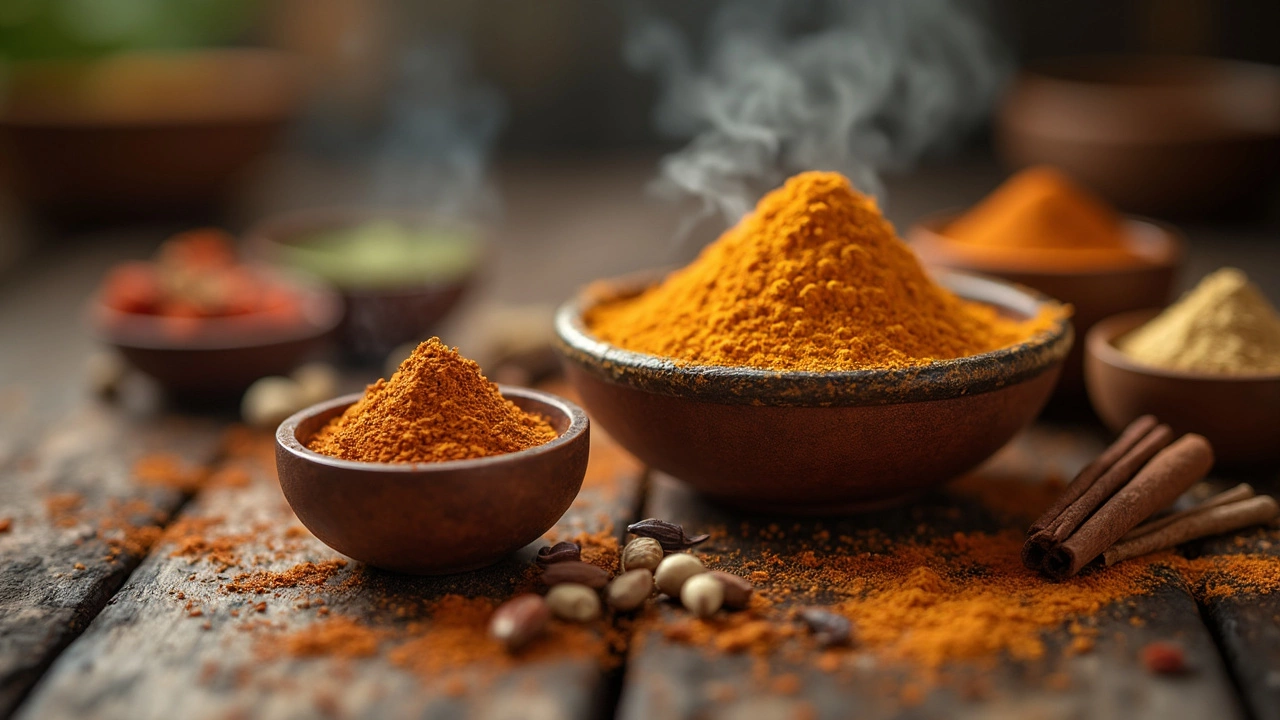Ever wondered why tandoori chicken has that irresistible flavor? The answer often lies in a magical ingredient called garam masala. This spice blend is a staple in many Indian kitchens, adding warmth and depth to dishes. But what's actually in it?
Garam masala typically includes cumin, coriander, cardamom, and cinnamon, among others. Each of these spices brings its own unique flair, creating a blend that's spicy, sweet, and slightly earthy. If you hunt for authenticity, knowing what's in your garam masala can make all the difference.
Whether you're whipping up a classic tandoori chicken or experimenting with your own creations, understanding garam masala is key. It's not just about taste—it's about crafting a meal that's full of aromas and flavors, authentically reflecting Indian cuisine.
- The Basics of Garam Masala
- Key Ingredients in Garam Masala
- Why Garam Masala is Essential for Tandoori Chicken
- Homemade vs. Store-bought Garam Masala
- Cooking Tips for Using Garam Masala
The Basics of Garam Masala
So, what exactly is garam masala? Well, at its core, it's a blend of a bunch of spices that come together to make magic. Think of it as the seasoning that can take a dish from bland to flavorful with just a sprinkle. Though the mix can vary quite a bit depending on who's making it, there are a few key players you'll almost always find.
Common Ingredients
The classic garam masala usually includes spices like cumin, coriander, cardamom, cinnamon, clove, and black pepper. Each spice has its own role, giving the blend a balance of spicy, sweet, and earthy flavors. For instance, cumin brings a warm, smoky taste, while cinnamon adds a bit of sweetness.
Regional Variations
The thing is, garam masala isn't a one-size-fits-all deal. Different regions of India tweak their blends, adding other spices or changing quantities to suit their local cuisine. Some might throw in bay leaves or nutmeg, while others swear by a bit of asafoetida. And that's the beauty of it—it's super adaptable to what you're cooking.
Tandoori chicken relies heavily on this magic mix to get that authentic zing. If you're all about staying traditional, knowing the basics of garam masala means you're already ahead in crafting a great dish. Whether you're buying it or making your own, understanding the core ingredients can help you customize it to fit your taste.
Key Ingredients in Garam Masala
When talking about garam masala, it's not just about its exotic name—it's the harmonious mix of spices that truly makes it shine. So, what's inside?
Common Ingredients
Garam masala doesn't have a one-size-fits-all recipe. However, there are several spices you're likely to find in most blends:
- Cumin: This spice offers an earthy, nutty flavor. It's essential for that rich aroma in tandoori chicken.
- Coriander: Known for its citrusy undertones, coriander balances out the warmth of other spices.
- Cardamom: It adds a sweet and floral hint, elevating the entire mix.
- Cinnamon: With its sweet and woody essence, cinnamon brings out the depth in savory dishes.
- Black Pepper: Provides a spicy kick, which is why it's a must in any Indian cuisine.
- Cloves: These buds add a pungent, slightly sweet spice to the blend.
The Magic of Ratios
Balancing these spices is an art. Too much cinnamon, and the blend can lean sweet. Overdo the pepper, and it might be too hot. Each household might have a slightly different ratio, but getting yours just right can make or break your tandoori chicken.
Fun Fact
Did you know that garam masala is often added at the end of cooking? This helps retain the aromatic qualities of the spices, unlike others that release flavors better when they simmer for longer.
Understanding these components isn't just about cooking well; it's about embracing the full experience. Next time you reach for that spice jar, you'll know exactly the magic you're about to sprinkle!

Why Garam Masala is Essential for Tandoori Chicken
When you're digging into a plate of tandoori chicken, there's one thing making it so memorable—the flavor-packed punch of garam masala. But why exactly is this spice blend so crucial?
The Secret to Authenticity
Without garam masala, tandoori chicken just wouldn't have the same depth. This blend isn't just a random mix of spices; it's a carefully balanced combination that enhances the chicken's natural taste. Think of it as the heartbeat of the dish—missing it would be like leaving salt out of fries.
Lending Complexity
The beauty of garam masala is in its complexity. With spices like cumin for earthiness, cinnamon for warmth, and cardamom for a hint of sweetness, each bite of your chicken is layered with multiple flavors. This complexity is what makes tandoori chicken stand out from ordinary grilled chicken.
Boosting Aroma
A huge part of enjoying food is the aroma. Garam masala fills your kitchen with an irresistible scent that tickles your senses even before you take the first bite. The aroma alone can transport you to a bustling Indian street market.
Health Benefits
Beyond taste and aroma, garam masala also has health perks. Many of its ingredients are known for their anti-inflammatory properties. So, while you’re indulging in tandoori chicken, you’re also treating your body to some added goodness.
- Cumin: Good for digestion
- Coriander: Can help control blood sugar
- Cardamom: Said to have antimicrobial properties
Homemade vs. Store-bought Garam Masala
When it comes to garam masala, there's a choice to be made: whip up your own mix or grab one off the supermarket shelf. Each has its pros and cons, and it really depends on what you're looking for in your tandoori chicken recipe.
Homemade Garam Masala
Making garam masala at home can be a game-changer. You get to control what goes into your mix, ensuring everything is fresh and aromatic. Plus, you can tweak the spices according to your taste—more cardamom for a sweeter touch or extra cumin for that earthy vibe.
The process is pretty straightforward. Here's a simple guide:
- Gather your spices like cumin, coriander, cardamom, cinnamon, cloves, nutmeg, and black pepper.
- Dry roast these spices on low heat until they release a nice aroma.
- Allow them to cool before grinding them up into a fine powder.
This might take some extra time, but the payoff is a blend that's fresh and customized just for you.
Store-bought Garam Masala
Store-bought versions are perfect if you're tight on time. Brands like MDH or Everest are popular choices in many kitchens, and they offer consistent flavor. These blends go through strict quality checks to ensure a uniform taste every time.
However, one downside is that you can't adjust the ratios or remove any particular spice. Also, some pre-packaged mixes might have added preservatives to extend shelf life. So, if freshness is your priority, give homemade a try instead.
Ultimately, whichever option you choose, garam masala is going to elevate your tandoori chicken. Just make sure your spices, whether homemade or store-bought, are stored properly in an airtight container to keep them fresh and fragrant for longer.

Cooking Tips for Using Garam Masala
Incorporating garam masala into your cooking isn't just about dumping it in and hoping for the best. A little finesse goes a long way, and here are some practical tips to help you make the most out of this flavorful spice mix.
When to Add Garam Masala
Timing is key. Typically, garam masala is added towards the end of cooking. This allows its rich aroma to shine through without losing its potency. For dishes like tandoori chicken, sprinkle some on just before serving to enhance its flavor profile.
Pairing with Other Spices
Garam masala can be combined with other spices like turmeric or chili powder to create a more complex taste. Be mindful of the balance, as garam masala is quite potent.
Using Garam Masala in Marinades
When marinating chicken for tandoori or any other dish, mix a small amount of garam masala with yogurt, lemon juice, and oil. This not only tenderizes the meat but also infuses it with layers of flavor.
Storing and Freshness
Store your garam masala in an airtight container, away from direct sunlight. Freshness matters because the strength of the spices can fade over time, typically after 6 months.
Experiment and Adjust
Since garam masala can vary based on regional recipes, don't hesitate to experiment. Taste your dish as you go, adjusting the amount to your preference.
| Step | Action | Tip |
|---|---|---|
| 1 | Add at the end | Preserves aroma |
| 2 | Mix with yogurt | Great for marinades |
| 3 | Store properly | Keep it fresh |
Armed with these tips, you'll be ready to transform any dish into a flavor-packed delight. So next time you're cooking, remember that with the right touch, garam masala can be the secret ingredient that steals the show.
